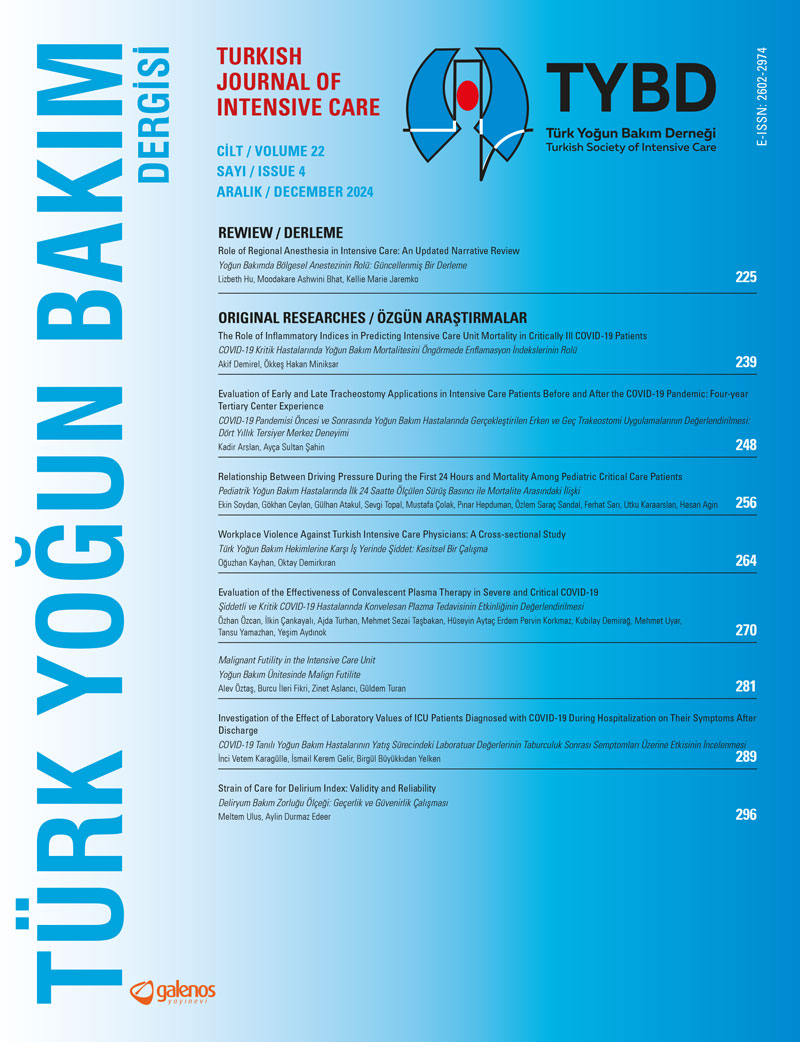Abstract
Objective:
Respiratory failure is one of the most common causes of mortality in pediatric intensive care unit (PICU) patients. Adult and a small number of pediatric studies have also associated driving pressure with mortality in ARDS patients, but studies showing the relationship between driving pressure and mortality in patients without ARDS are inconsistent and limited. This study aimed to determine whether driving pressure was associated with mortality in pediatric patients diagnosed as pediatric ARDS (pARDS) and non-pARDS who received mechanical ventilation support due to respiratory failure.
Materials and Methods:
Mechanically ventilated patients were recorded if the foreseen ventilation duration was more than 24 hours. Driving pressure and other ventilator parameters of patients in the pARDS and non-pARDS groups were compared with their 30-day mortality.
Results:
A total of 116 children were included in our study. 34 patients were classified in pARDS group, whereas 82 patients werein non-PARDS group. All patients’first day of mechanical ventilation parameters [ΔP (p<0,001), PIP (p<0,001), Pplat (p<0,001), Pmean (p=0,008), Cstat (p<0,001), Cstat/IBW (p<0,001), FiO2 (p=0,001)] werefound to be associated with hospital mortality. Driving pressure and other ventilator parameters associated with mortality in the univariate analysis were further evaluated by logistic regression analysis and driving pressure was determined as the most associated ventilator parameter with mortality (OR=1,51, 95% CI 1.24 to 1.82, p = <0.001). We assessed independently the relationship between ΔP and mortality in patients non-pARDS and pARDS and we found ΔP was related to mortality in both patients (OR=1,59, 95% CI 1.06 to 2.36, p <0.022) and non-ARDS patients (OR=1,47, 95% CI 1.09 to 1.98, p <0.010). We identified a driving pressure cut-off value of 14,5 cmH2O for all patient groups.
Conclusion:
Driving pressure was significantly associated with an increased risk of mortality among mechanically ventilated both pARDS and non-pARDS patients.
Keywords: Driving pressure, pediatric intensive care unit, mortality, pediatric acute respiratory distress syndrome
Introduction
Respiratory failure is one of the most common causes of hospitalization and mortality in patients in the pediatric intensive care unit (PICU). Although positive pressure mechanical ventilation is a life-saving treatment, it is associated with risks of morbidity and mortality. Although there is a consensus on mechanical ventilation in adult patients, this knowledge should be reflected in concrete data for the pediatric population (1-4). Mechanical ventilation with high tidal volumes may damage the lung through alveolar overdistension (volutrauma and barotrauma) and by causing the release of inflammatory cytokines (biotrauma) into the systemic circulation (5, 6). Recently, it has been suggested to target driving pressure (ΔP) in ARDS patients to achieve improved outcomes with optimal mechanical ventilation (7-10). ΔP is calculated as the difference between the Plateau pressure (Pplat) and positive end-expiratory pressure (PEEP) and is derived by dividing tidal volume by respiratory system compliance (ΔP=Pplat-PEEP). This measure estimates the mechanical strain (dynamic strain) caused by lung tidal volume. It is a non-invasive, straightforward method that can be easily performed at the bedside (10-12). Numerous studies have found an association between higher ΔP values and increased mortality in adults with ARDS. However, studies examining the relationship between driving pressure and mortality in patients with non-ARDS are limited, and the results have been contradictory (13-18).
This study investigates whether ΔP is associated with mortality in pediatric patients diagnosed with pARDS and non-pARDS who received mechanical ventilation support due to respiratory failure.
Materials and methods
This prospective, single-center observational study included patients admitted to the PICU. The study protocol was approved by the University of Health Sciences Turkey, Dr. Behçet Uz Child Diseases and Surgery Training and Research Hospital Clinical Research Ethics Committee (decision no: 2020/07-02, date: 07.05.2020). Written informed consent was obtained from the parents/caregivers after the patient's initial clinical stabilization period. The study included patients aged between 1 month and 18 years who required invasive mechanical ventilation support due to respiratory failure in the PICU and were admitted between March 2018 and April 2020. Patients were excluded if they received ventilation via a tracheostomy cannula or if they were extubated or died within the first 24 hours of ventilation.
Only patients who received at least 24 hours of mechanical ventilation were included in the analysis. Patients were divided into two groups based on the oxygenation index (OI), calculated using the formula: [mean airway pressure (MAP)xfraction of inspired oxygen (FiO2)]/partial pressure of oxygen in arterial blood (PaO2)x100, by the pediatric acute lung injury and sepsis consensus conference (PALICC) criteria for defining ARDS and non-ARDS. The PARDS definition was similarly based on the PALICC guidelines (3). On day 1, data were prospectively recorded, including patient demographics, ventilator settings (VT, VT/ideal body weight [IBW], respiratory rate, peak inspiratory pressure [PIP], Pplat, MAP [Pmean], minute volume, PEEP, static compliance [Cstat], FiO2, inspiratory time, and expiratory time). Additionally, the OI, Cstat (VT/ΔP), PaO2/FiO2 ratio, driving pressure (ΔP), PRISM III score, and pediatric sequential organ failure assessment (pSOFA) scores were calculated.
All patients were ventilated in pressure control mode throughout their hospitalization. Ventilator data were recorded twice within each 24 hours. Driving pressure was measured by obtaining Pplat every 12 hours using an inspiratory hold maneuver, with the mean Pplat value calculated from two measurements within 24 hours.
Total PEEP was measured using an expiratory hold maneuver, with the mean total PEEP value also calculated from two measurements within 24 hours; ΔP was then calculated using the formula Pplat PEEP. Neuromuscular blocking agents were administered to all patients before the measurements. Each patient was monitored for up to 30 days or until hospital discharge. ΔP was compared with other mechanical ventilator parameters between survivors and non-survivors at day 30, and ΔP and other parameters were also compared between the ARDS and non-ARDS groups based on 30-day mortality outcomes.
Statistical Analysis
Our primary objective was to assess the association between ΔP and mortality in patients with ARDS and non-ARDS. Second, we aimed to analyze the relationship between mortality and ΔP along with other mechanical ventilation parameters. Comparisons of driving pressure and other lung dynamics, depending on the data type and distribution, were conducted using the chi-square test, Wilcoxon’s independent t-test, or Mann-Whitney U test, with a p-value of <0.05 as statistically significant. The correlation coefficient was used to gauge the strength of the associations between variables. Pearson’s correlation was applied for parametric data and Spearman’s correlation for non-parametric data to identify covariances before logistic regression. Spearman’s correlation analysis was used to detect covariances.
Variables found to have significant associations with mortality in univariate analyses were further assessed by logistic regression [reporting odds ratio (OR) and 95% confidence intervals (CI)]. Model adequacy was evaluated with Hosmer-Lemeshow goodness-of-fit statistics. The multivariable analyses identified covariates potentially related to mortality. We ensured that VT/IBW, PaO2, OI, FiO2, PRISM III score, days of ventilation, and pSOFA score were not collinear with ΔP. Pplat, PIP, and Pmean were excluded from logistic regression models containing ΔP due to concerns regarding collinearity. Separate models were generated for Pplat, PIP, and Pmean due to their collinearity with the driving pressure.
The final model was used to identify the most relevant parameter associated with 30- day mortality in patients receiving mechanical ventilation for respiratory failure. ΔP cut-off values in our study were classified, and mortality predictions were calculated using receiver operating characteristic analysis (19, 20). All statistical data were analyzed using IBM SPSS Statistics for Windows, version 22 (Armonk, NY).
Results
Between March 2018 and April 2020, 263 patients received invasive mechanical ventilation support in our admitted to the PICU. However, 144 patients who did not meet the inclusion criteria were excluded from the study. A total of 116 children were included in the study. The median duration of mechanical ventilation was 7 days (IQR: 9-14 days). Sepsis (31.8%) was the most common reason for the need for mechanical ventilation. Followed by lower respiratory tract infection (28.4%). Thirty four patients were included in the pARDS group and 82 in the non-pARDS group. Patients with pARDS or non-pARDS had no statistically significant pSOFA values (p-value: 0.063), however, patients with pARDS had higher PRISM III scores (p-value<0.001) than non-pARDS patients (p<0.010). Characteristics were reported in (Table 1).
| Table 1. Demographic and clinical characteristics with pARDS and non-pARDS patients | |||
|
Characteristic |
pARDS patients (n=34) |
non-pARDS patients (n=82) |
p-value |
|
Age (months) |
15.6 (9-35) |
13.5 (7-24.4) |
0.117 |
|
Female gender, n (%) |
17.0 (50%) |
34.0 (41.5%) |
0.401 |
|
Days of ventilation |
13.1 (8.6-17.0) |
8.5 (6.3-12.1) |
0.010 |
|
Admission diagnosis, n (%) |
|||
|
Sepsis |
12 (32.4%) |
25 (30.5%) |
|
|
Pneumonia |
10 (29.5%) |
23 (28.1%) |
|
|
Neurological diseases |
9 (26.5%) |
25 (30.5%) |
|
|
Cardiological diseases |
1 (2.9%) |
3 (3.7%) |
|
|
Hematologic diseases |
1 (2.9%) |
2 (2.4%) |
|
|
Post-surgery |
1 (2.9%) |
2 (2.4%) |
|
|
Immun deficiency |
1 (2.9%) |
2 (2.4%) |
|
|
30-day mortality, (n) % |
8 (23.5%) |
15 (18.2%) |
<0.001 |
|
pARDS n (%) |
|||
|
Mild pARDS n (%) |
17 (50.0%) |
||
|
Moderate pARDS n (%) |
9 (26.5%) |
||
|
Severe pARDS n (%) |
8 (23.5%) |
||
| Parametric data are presented as mean ± 1 standard deviation or non-parametric data presented as median (first and third quartiles), pARDS: Acute respiratory distress syndrome | |||
Among the included patients, 17 had mild, 9 had moderate, and 8 had severe pARDS. There were no differences in admission diagnosis and mortality on 30 days between the ARDS and non-ARDS groups. There were 93 survivors and 23 non-survivors at 30 days. The comparison between survivors and non-survivors at day 30 is shown in (Table 2).
| Table 2. Mechanical ventilator parameters and clinical findings of all patients according to hospital mortality | |||
|
Variable |
Survivors at day 30 (n=93) |
Non-survivors at day 30 (n=23) |
p-value |
|
VT (ml) |
71.9 (51.3-108.5) |
82.0 (61.5-120.9) |
0.180 |
|
VT/IBW (mL/kg) |
7.0 (6.0-8.1) |
6.5 (5.0-9.0) |
0.292 |
|
VE (L/min) |
2.8 (2.1-4.1) |
2.3 (1.7-3.8) |
0.117 |
|
RR (bpm) |
34.0 (34.0-40.0) |
35.0 (30-42) |
0.862 |
|
PIP (cm H2O) |
23.6 (19.5-26) |
29.0 (25.0-34.0) |
<0.001 |
|
Pplat (cm H2O) |
21.0 (19.0-25.0) |
28.0 (24.0.-33.0) |
<0.001 |
|
PEEP (cm H2O) |
7.0 (6.0-9.0) |
7.0 (6.0-7.0) |
0.221 |
|
ΔP (cm H2O) |
16.0 (13.0-18.0) |
23.0 (19.0-26.0) |
<0.001 |
|
Pmean (cm H2O) |
11.7 (10.3-13.6) |
13.1 (12.2-18.2) |
0.008 |
|
Cstat (mL/cmH2O) |
5.7 (3.5-8.1) |
2.8 (2.0-5.7) |
<0.001 |
|
Cstat/İBW (mL/cm H2O/kg) |
0.4 (0.3-0.6) |
0.3 (0.2-0.4) |
<0.001 |
|
IT (s) |
0.6 (0.5-0.7) |
0.6 (0.5-0.9) |
0.986 |
|
ET (s) |
1.1 (0.9-1.3) |
1.1 (0.8-1.2) |
0.551 |
|
FiO2 ( %) |
35.0 (30.0-44.0) |
40.0 (40.0-60.0) |
0.001 |
|
OI |
3.3 (2.5-3.7) |
4.8 (3.2-12.1) |
<0.001 |
|
PaCO2 (mmHg) |
48.0 (±6.7) |
50.3 (±7.6) |
0.225 |
|
PaCO2, (mmHg) |
122.3 (±26.4) |
100.7 (±28.7) |
0.008 |
|
Days of ventilation |
10.5 (7.0-13.5) |
8.0 (7.0-15.0) |
0.010 |
|
PRISM III score |
5.0 (2.3-8.8) |
7.3 (2.0-10.0) |
<0.001 |
|
pSOFA score |
5.0 (4.0-7.0) |
6.0 (5.0-9.0) |
0.063 |
| Parametric data are presented as mean ± 1 standard deviation or non-parametric data presented as median (first and third quartiles),VT: tidal volume, VT/İBW: tidal volume/ideal body weight, RR: Respiratory rate, PIP: Peak inspiratory pressure, Pplat: Plateau pressure, Pmean: Mean airway pressure, VE: minute volume, PEEP: Positive end-expiratory pressure, Cstat :static compliance, FIO2: fraction of inspired oxygen, Is: İnspiratory time , ET: Expiratory time, OI:Oxygenation index, ΔP: driving pressure, Cstat: static compiance, PRISM III score: The pediatric index of mortality scores, MV: mechanical ventilator, PaO2: partial pressure of oxygen | |||
All patients’ mechanical ventilation parameters on the first day were [∆P (p<0.001), PIP (p<0.001), Pplat (p<0.001), Pmean (p=0.008), Cstat (p<0.001), Cstat/IBW (p<0.001), FiO2 (p=0.001)] associated with hospital mortality. OI, PaO2, and days of ventilation were also associated with 30-day mortality in all patients (p<0.001, p=0.008, p=0.010, respectively). There was no significant association between VT/IBW (p=0.292), IT (p=0.986), ET (p=0.551), PEEP (p<0.221), RR (p=0.862), and 30- day mortality in all patients.
The primary regression model aimed to determine the effect of ∆P on 30- day mortality in all patients and the mechanical ventilator parameter most associated with 30- day mortality. Second, we aimed to determine the association of ∆P with 30- day mortality in patients with and without ARDS. As the collinearity between ΔP, PIP, Pplat, and Pmean was statistically significant, a logistic regression model was constructed for each of these variables (Table 3). ∆P was most associated with 30- day mortality (OR=1.51, 95% CI 1.24 to 1.82, p≤0.001). The Pmean was not associated with 30- day mortality in any of the patients (OR=1.31, 95% CI 0.98 to 1.73, p=0.062). We conducted separate analyses to determine the relationship between ΔP and mortality in patients with non-ARDS and ARDS, we found ΔP related to mortality in both patient groups (OR=1.59, 95% CI 1.06 to 2.36, p<0.022) and non-ARDS patients (OR=1.47, 95% CI 1.09 to 1.98, p<0.010) (Table 4).
| Table 3. Multivariable logistic regression model at hospital mortality for ΔP, PIP, Pplat and Pmean | |||
|
MODEL 1 |
MODEL 2 |
MODEL 3 |
MODEL 4 |
|
Variable OR (95% CI) p-value |
Variable OR (95% CI) p-value |
Variable OR (95% CI) p-value |
Variable OR (95% CI) p-value |
|
Age 1.01 (0.98-1.03) 0.304 |
Age 1.01(0.99-1.03) 0.313 |
Age 1.01 (0.98-1.03) 0.304 |
Age 1.00 (0.98-1.02) 0.494 |
|
Gender 0.16 (0.03-0.73) 0.018 |
Gender 0.28(0.06-0.85) 0.028 |
Gender 0.24 (0.86-1.06) 0.030 |
Gender 0.39 (0.12-1.22) 0.018 |
|
OI 0.68 (0.51-0.91) 0.011 |
OI 0.69 (0.52-0.92) 0.011 |
OI 0.68 (0.51-0.90) 0.008 |
OI 0.62 (0.42-0.91) 0.014 |
|
PaO2 0.98 (0.95-1.01) 0.302 |
PaO2 0.98 (0.95-1.01) 0.214 |
PaO2 0.98 (0.95-1.00) 0.182 |
PaO2 0.97 (0.94-1.00) 0.093 |
|
FiO2 1.13 (1.01-1.27) 0.032 |
FiO2 1.15 (1.03-1.28) 0.010 |
FiO2 1.15 (1.03-1.28) 0.011 |
FiO2 1.20 (1.07-1.35) 0.001 |
|
PRISM III 0.90 (0.77-1.05) 0.194 |
PRISM III 0.87 (0.76-1.01) 0.085 |
PRISM III 0.87 (0.76-1.01) 0.086 |
PRISM III 0.89 (0.77-1.03) 0.126 |
|
Day (MV) 0.90 (0.76-1.06) 0.901 |
Day (MV) 0.91 (0.78-1.05) 0.910 |
Day (MV) 0.90 (0.78-1.04) 0.184 |
Day (MV) 0.93 (0.82-1.05) 0.273 |
|
ΔP 1.51 (1.24-1.82) <0.001 |
PIP 1.26 (1.10-1.44) 0.028 |
Pplato 1.29 (1.12-1.50) 0.001 |
Pmean 1.31 (0.98-1.73) 0.062 |
| OR: Odd ratio, CI: confidence interval, FIO2: fraction of inspired oxygen, OI:Oxygenation index Oİ, ΔP: driving pressure, PIP: Peak inspiratory pressure, Pplat: Plateau pressure, Pmean: Mean airway pressure, PRISM III score: The pediatric index of mortality scores, MV: mechanical ventilator, PaO2: partial pressure of oxygen | |||
| Table 4. A multivariable logistic regression model with pARDS patients and non-pARDS patients for ΔP | ||
|
pARDS Patients ΔP model |
non-pARDS patients ΔP Model |
All patients ΔP Model |
|
Variable OR (95% C p-value |
Variable OR (95% CI) p-value |
Variable OR (95% CI) p-value |
|
Age 1.02 (0.98-1.06) 0.164 |
Age 0.96 (0.87-1.06) 0.482 |
Age 1.01 (0.98-1.03) 0.304 |
|
Gender 0.11 (0.00-1.74) 0.120 |
Gender 0.09 (0.00-1.00) 0.051 |
Gender 0.16 (0.03-0.73) 0.018 |
|
OI 0.68 (0.44-1.05) 0.084 |
OI 0.62 (0.04-9.01) 0.729 |
OI 0.68 (0.51-0.91) 0.011 |
|
PaO2 1.05 (0.96-1.16) 0.255 |
PaO2 0.97 (0.91-1.04) 0.255 |
PaO2 0.98 (0.95-1.01) 0.302 |
|
FiO2 1.16 (0.95-1.42) 0.144 |
FiO2 1.14 (0.89-1.46) 0.145 |
FiO2 1.13 (1.01-1.27) 0.032 |
|
PRISM III 0.90 (0.71-1.15) 0.429 |
PRISM III 0.81 (0.59-1.12) 0.217 |
PRISM III 0.90(0.77-1.05) 0.194 |
|
Day (MV) 0.83 (0.65-1.06) 0.143 |
Day (MV) 0.98 (0.77-1.25) 0.904 |
Day (MV) 0.90 (0.76-1.06) 0.901 |
|
ΔP 1.59 (1.06-2.36) 0.022 |
ΔP 1.47 (1.09-1.98) 0.010 |
ΔP 1.51 (1.24-1.82) <0.001 |
| OR: Odd ratio, CI: confidence interval, FIO2: fraction of inspired oxygen, OI:Oxygenation index Oİ, ΔP: driving pressure, PIP: Peak inspiratory pressure, Pplat: Plateau pressure, Pmean: Mean airway pressure, PRISM III score: The pediatric index of mortality scores, MV: mechanical ventilator, PaO2: partial pressure of oxygen | ||
After evaluating the relationship between inspiratory airway pressures (ΔP, PIP, Pmean, Pplat) and 30- day mortality by logistic regression analysis, we also compared these 4 parameters with ROC analysis for ΔP area under the curve was 0.838 (95% CI, 0.738-0.939, p<0.001), Pplat 0.770 (95% CI, 0,662-0,878, p<0.001), PIP 0.762 (95% CI, 0.648-0.876, p<0.001) and Pmean 0.678 (95% CI, 0.558–0.798, p=0.008). When assessing the risk of death at each level of ΔP. We defined the cut-off value related to mortality in our study as 17 cm H2O in patients with pARDS, 13 cm H2O in patients without ARDS, and 14,5 cm H2O in all patients. We found the overall mortality rate to be 10.2 times higher for patients with ΔP greater than 14.5 cm H2O compared with patients whose ΔP was 14.5 cm H2O (OR=10.2, 95% CI 1.37 to 70, 75, p<0.001).
Discussion
Mechanical ventilation remains one of the primary reasons for admission to admitted to the PICUs, with approximately 64% of admitted children requiring this intervention (21, 22). Driving pressure (ΔP), calculated as the difference between end-inspiratory Pplat and applied PEEP, represents the ratio of tidal volume (VT) to respiratory system compliance. P has shown potential in reducing mortality among children receiving mechanical ventilation for respiratory failure. ΔP offers a simple, noninvasive approach and can be measured directly at the bedside.
In recent years, data from studies on adult ARDS have indicated that ΔP is strongly associated with mortality (10, 23). Our study demonstrated that ΔP on day 1 was correlated with hospital mortality in patients with pARDS. Although the PALICC guidelines have not yet recommended targeting ΔP in patients with pARDS, the connection between ΔP and mortality in patients with ARDS is well established. However, this association remains unclear in patients without ARDS. A meta-analysis by Serpa Neto et al. (15) revealed increased postoperative lung complications with elevated ΔP during general anesthesia (24). In two previous studies, no significant relationship was observed between ΔP and mortality in non-ARDS patients (14, 18). Our findings similarly indicate that ΔP on day 1 was related to 30-day mortality among non-pARDS patients receiving mechanical ventilation for respiratory failure. Mechanical ventilation was applied without targeting low tidal volume or specific ΔP values, suggesting that higher ΔP may increase the mortality risk in patients without ARDS due to elevated inspiratory pressures. Numerous recent studies highlight the significance of driving pressure on survival outcomes (25-29), and many ARDS studies have found associations between VT and mortality in pediatric patients (8, 25, 26). However, in our study, we observed no significant association between VT and mortality in pARDS and non-pARDS patients. This might explain the observed mortality association with ΔP and compliance in patients with pARDS.
Current adult ARDS data suggest that driving pressure is more closely associated with mortality than inspiratory pressure (10, 23). Some pediatric studies have also identified linear correlations between mortality and PIP and Pplat (8, 25). Higher inspiratory pressures (PIP, Pplat, Pmean, ΔP) were associated with 30- day mortality.
Using four distinct multivariate regression models, we found that ΔP had the strongest association with mortality. Each 1-SD increase in ΔP (approximately 7 cm H2O) increased the mortality risk by 51% (10). ΔP cut-off values varied from 13 to 21 cm H2O (10, 27, 28), and in our study, cut-offs were defined as 17 cm H2O for patients with ARDS, 13 cm H2O for patients without ARDS, and 14.5 cm H2O for all patients collectively.
This study has notable strengths. This is among the few prospective studies exploring the link between ΔP and mortality in both pARDS and non-pARDS patients, with ΔP and other ventilatory parameters measured using hold maneuvers to minimize patient effort and provide detailed data.
However, there are limitations. First, only the initial 24- h ventilator settings were analyzed; subsequent ventilator pressure changes due to dynamic lung responses were not captured. Additionally, as a single-center study, the findings may be limited in generalizability.
Conclusion
In this single-center prospective observational study, driving pressure was significantly associated with an increased mortality risk in patients with pARDS and non-pARDS undergoing mechanical ventilation. Future randomized multicenter studies are needed to establish protocols targeting ΔP and determine optimal cut-off values.
Ethics
References
- Ferguson ND, Fan E, Camporota L, Antonelli M, Anzueto A, Beale R, et al. The Berlin definition of ARDS: an expanded rationale, justification, and supplementary material. Intensive Care Med. 2012;38:1573-82. Erratum in: Intensive Care Med. 2012;38:1731-2.
- Santschi M, Jouvet P, Leclerc F, Gauvin F, Newth CJ, Carroll CL, et al. Acute lung injury in children: therapeutic practice and feasibility of international clinical trials. Pediatr Crit Care Med. 2010;11:681-9.
- Pediatric Acute Lung Injury Consensus Conference Group. Pediatric acute respiratory distress syndrome: consensus recommendations from the Pediatric Acute Lung Injury Consensus Conference. Pediatr Crit Care Med. 2015;16:428-39.
- Kneyber MCJ, de Luca D, Calderini E, Jarreau PH, Javouhey E, Lopez-Herce J, et al. Recommendations for mechanical ventilation of critically ill children from the Paediatric Mechanical Ventilation Consensus Conference (PEMVECC). Intensive Care Med. 2017;43:1764-80.
- Acute Respiratory Distress Syndrome Network; Brower RG, Matthay MA, Morris A, Schoenfeld D, Thompson BT, et al. Ventilation with lower tidal volumes as compared with traditional tidal volumes for acute lung injury and the acute respiratory distress syndrome. N Engl J Med. 2000;342:1301-8.
- Slutsky AS, Ranieri VM. Ventilator-induced lung injury. N Engl J Med. 2013;369:2126-36.
- Guo L, Xie J, Huang Y, Pan C, Yang Y, Qiu H, et al. Higher PEEP improves outcomes in ARDS patients with clinically objective positive oxygenation response to PEEP: a systematic review and meta-analysis. BMC Anesthesiol. 2018;18:172.
- Khemani RG, Conti D, Alonzo TA, Bart RD 3rd, Newth CJ. Effect of tidal volume in children with acute hypoxemic respiratory failure. Intensive Care Med. 2009;35:1428-37.
- Briel M, Meade M, Mercat A, Brower RG, Talmor D, Walter SD, et al. Higher vs lower positive end-expiratory pressure in patients with acute lung injury and acute respiratory distress syndrome: systematic review and meta-analysis. JAMA. 2010;303:865-73.
- Amato MB, Meade MO, Slutsky AS, Brochard L, Costa EL, Schoenfeld DA, et al. Driving pressure and survival in the acute respiratory distress syndrome. N Engl J Med. 2015;372:747-55.
- Aoyama H, Pettenuzzo T, Aoyama K, Pinto R, Englesakis M, Fan E. Association of Driving Pressure with Mortality among Ventilated Patients with Acute Respiratory Distress Syndrome: a systematic review and meta-analysis. Crit Care Med. 2018;46:300-6.
- Chen Z, Wei X, Liu G, Tai Q, Zheng D, Xie W, et al. Higher vs. Lower DP for Ventilated Patients with Acute Respiratory Distress Syndrome: A Systematic Review and Meta-Analysis. Emerg Med Int. 2019;2019:4654705.
- Guérin C, Papazian L, Reignier J, Ayzac L, Loundou A, Forel JM; et al. Effect of driving pressure on mortality in ARDS patients during lung protective mechanical ventilation in two randomized controlled trials. Crit Care. 2016;20:384.
- Lanspa MJ, Peltan ID, Jacobs JR, Sorensen JS, Carpenter L, Ferraro JP, et al. Driving pressure is not associated with mortality in mechanically ventilated patients without ARDS. Crit Care. 2019;23:424.
- Serpa Neto A, Cardoso SO, Manetta JA, Pereira VG, Espósito DC, Pasqualucci Mde O, et al. Association between use of lung-protective ventilation with lower tidal volumes and clinical outcomes among patients without acute respiratory distress syndrome: a meta-analysis. JAMA. 2012;308:1651-9.
- Flori HR, Glidden DV, Rutherford GW, Matthay MA. Pediatric acute lung injury: prospective evaluation of risk factors associated with mortality. Am J Respir Crit Care Med. 2005;171:995-1001.
- Dahlem P, van Aalderen WMC, Hamaker ME, Dijkgraaf MGW, Bos AP. Incidence and short-term outcome of acute lung injury in mechanically ventilated children. Eur Respir J. 2003;22:980-5.
- Schmidt MFS, Amaral A, Fan E, Rubenfeld GD. Driving pressure and hospital mortality in patients without ARDS: a cohort study. Chest. 2018;153:46-54.
- Chiumello D, Carlesso E, Brioni M, Cressoni M. Airway driving pressure and lung stress in ARDS patients. Crit Care. 2016;20:276.
- Raymondos K, Dirks T, Quintel M, Molitoris U, Ahrens J, Dieck T, et al. Outcome of acute respiratory distress syndrome in university and non-university hospitals in Germany. Crit Care. 2017;21:122.
- Farias JA, Frutos F, Esteban A, Flores JC, Retta A, Baltodano A, et al. What is the daily practice of mechanical ventilation in pediatric intensive care units? A multicenter study. Intensive Care Med. 2004;30:918-25.
- Randolph AG, Meert KL, O’Neil ME, Hanson JH, Luckett PM, Arnold JH, et al. The feasibility of conducting clinical trials in infants and children with acute respiratory failure. Am J Respir Crit Care Med. 2003;167:1334-40.
- Henderson WR, Chen L, Amato MB, Brochard LJ. Fifty years of research in ARDS: respiratory mechanics in acute respiratory distress syndrome. Am J Respir Crit Care Med. 2017;196:822-33.
- Neto AS, Simonis FD, Barbas CS, Biehl M, Determann RM, Elmer J, et al. Lung-protective ventilation with low tidal volumes and the occurrence of pulmonary complications in patients without acute respiratory distress syndrome: a systematic review and individual patient data analysis. Crit Care Med. 2015;43:2155-63.
- Erickson S, Schibler A, Numa A, Nuthall G, Yung M, Pascoe E, et al. Acute lung injury in pediatric intensive care in Australia and New Zealand: a prospective, multicenter, observational study. Pediatr Crit Care Med. 2007;8:317-23.
- Zhu YF, Xu F, Lu XL, Wang Y, Chen JL, Chao JX, et al. Mortality and morbidity of acute hypoxemic respiratory failure and acute respiratory distress syndrome in infants and young children. Chin Med J. 2012;125:2265-71.
- Bellani G, Laffey JG, Pham T, Fan E, Brochard L, Esteban A, et al. Epidemiology, patterns of care, and mortality for patients with acute respiratory distress syndrome in intensive care units in 50 countries. JAMA. 2016;315:788-800.
- Laffey JG, Bellani G, Pham T, Fan E, Madotto F, Bajwa EK, et al. LUNG SAFE Investigators and the ESICM Trials Group: Potentially modifiable factors contributing to outcome from acute respiratory distress syndrome: The LUNG SAFE study. Intensive Care Med. 2016;42:1865-76.
- Ceylan G, Topal S, Atakul G, Colak M, Soydan E, Sandal O, et al. Randomized crossover trial to compare driving pressures in a closed-loop and a conventional mechanical ventilation mode in pediatric patients. Pediatr Pulmonol. 2021;56:3035-43.
Copyright and license
Copyright © 2024 The Author(s). This is an open access article distributed under the Creative Commons Attribution License (CC BY), which permits unrestricted use, distribution, and reproduction in any medium or format, provided the original work is properly cited.






















